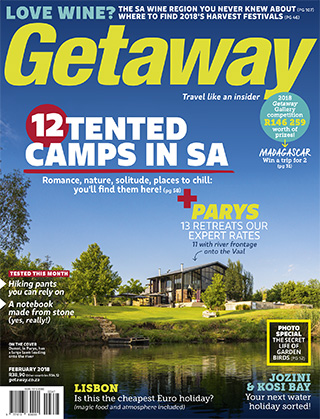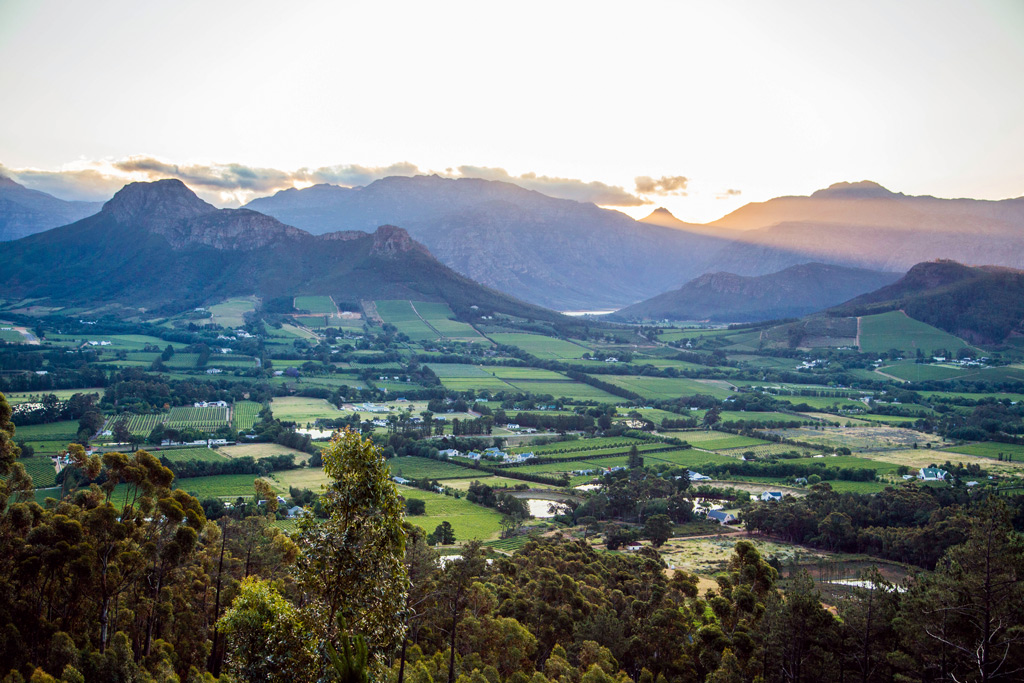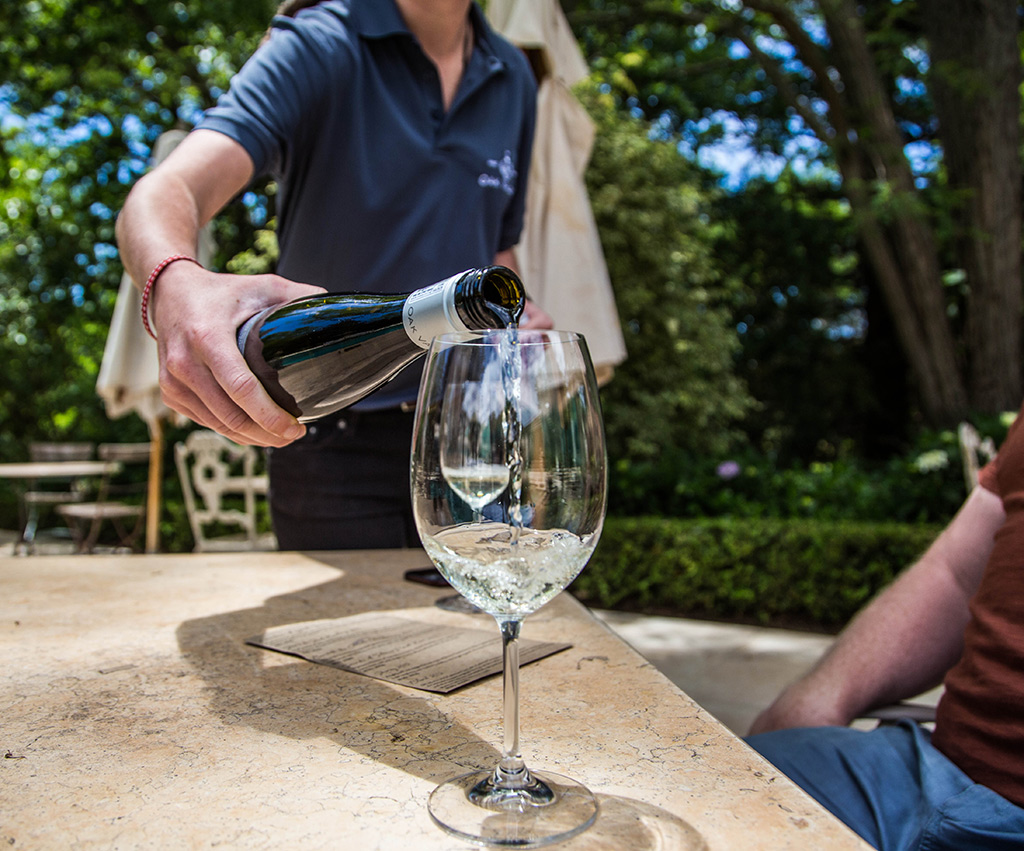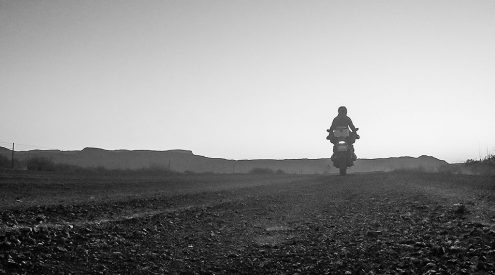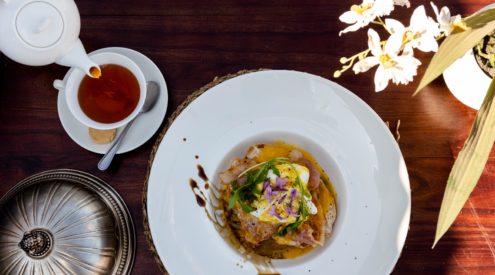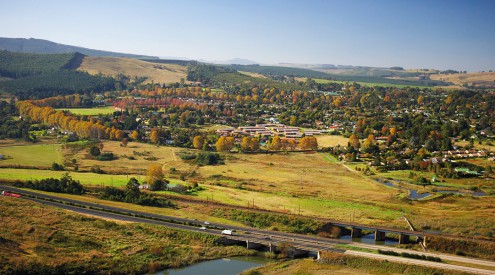A friend’s dad, who has a glorious moustache and thus can be trusted, once told me that a wine is like a human being, each one has a story and to truly understand it you must go to its source.
For some reason, wines taste better among the vineyards in which they’re grown. So I set off with my friend Jeff Kleu, a natural charmer and notorious violator of song lyrics, to explore the Winelands and unearth its best stories. The wine drinking promised to be a happy by-product.
We left Cape Town on a glittering, early-summer morning. Within half an hour we hit Durbanville’s vineyards. When these farms were established 300 years ago, it took a day in a wagon to get across the sands of the Cape Flats. Instead of sand, today chugging tractors slow traffic.

Stopping to enjoy the view over the Franschhoek Valley. Image: Matthew Sterne
At Altydgedacht, we met Ollo Parker, a fifth-generation wine farmer whose mother tended the vines when the men left to serve in World War II. We tasted a varietal I had never heard of. It’s called a Barbera. We also learnt that Italy alone has over 800 varietals. So now there are just 798 wines from Italy I don’t know about. We then skipped through the Northern Suburbs and headed for the mountains.
At Muratie Wine Estate in Stellenbosch, ancient oak trees surround its buildings like natural guardians. Inside is a tasting room with 40-year-old cobwebs as thick as wool in the windows.
We had a late lunch in the restaurant amidst old wine bottles and paintings of a scantily-clad woman named Amber. She has a wine named after her and was the muse of a former owner – ‘a worshipper of wine, women, and song’.
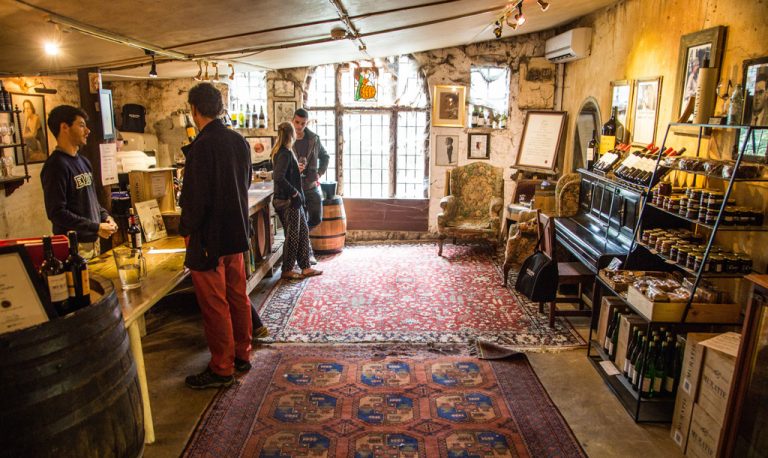
The tasting room at Muratie Wine Estate, where cobwebs as thick as wool hang in the windows. Image: Matthew Sterne
As the sun slipped lower and the day emptied its glass, we hooked around Simonsberg Mountain on the old Simondium Road. We turned the music up and I was feeling so good I even let Jeff desecrate the songs with his own wine-inspired versions. We passed farm workers in blue overalls tending the vines and crossed a railway just as the tourist-laden, double-decker wine tram rolled past.
Our final stop that day was Stony Brook Vineyards in upper Franschhoek, a boutique farm with three rivers running through it. We arrived just in time for a tasting with vintner Craig Mcnaught. He took us through the impressive wines and patiently answered our questions. ‘What is viscosity? What does “structure” mean? How do people come up with tasting notes such as pickled coriander, oyster shell, and forest floor?’
‘A lot of winemakers choose their harvest dates according to the pH, sugar and acidity levels in the grapes. Others trust their taste buds and pick based on flavours,’ said Craig. ‘The art of making wine is finding the balance between the two.’
It reminded me of a sentiment I’d heard about design and architecture; how function must balance with form. Road trips, too, are an art – you need to find the sweet spot between planning and spontaneity. Too much planning and it lacks adventure. Too little and you sleep in your car and eat cheeseburger pies for breakfast.
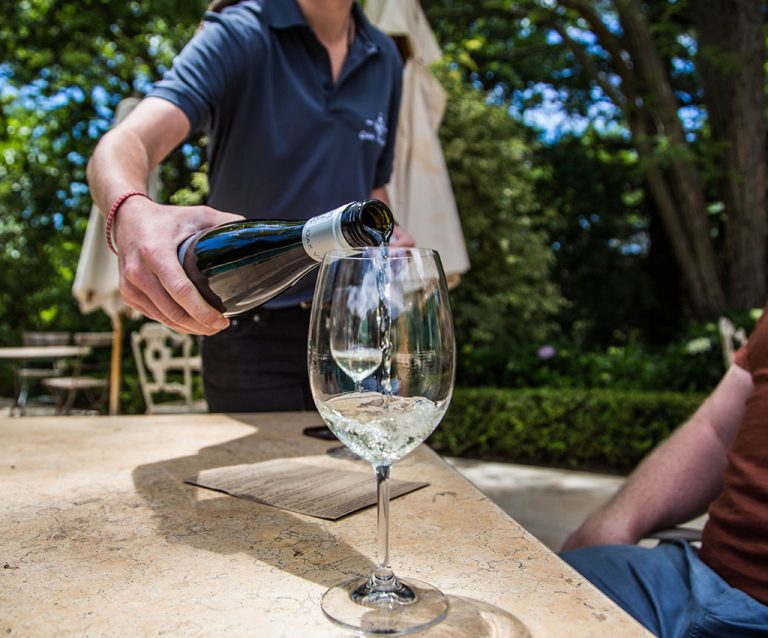
Wine tasting at Oak Valley. Image: Matthew Sterne
Farm noises woke us the next day – a mooing cow, a passing tractor, workers shouting. After a refreshing walk up to the dam, we zipped up Franschhoek Pass, passed Theewaterskloof Dam and headed to Oak Valley Wine Estate in Elgin for breakfast. It’s home to more than 4000 oak trees and, as per the original owner’s stipulation, not one may be cut down. The pigs are fed the acorns, which gives their meat a nuttier, richer taste.
We crossed the N2 and followed Highlands Road (how can you not take a road with a name like that?) past small dams, vineyards, boys on bicycles, and a rickety bus full of children waving wildly.
The road turned to gravel and as we wound over a small pass three blue cranes flew overhead. We continued towards Hermanus and took the turnoff to the Hemel-en-Aarde Valley, a relatively young and close-knit wine region known for its crisp whites which benefit from the cool sea breeze off Walker Bay.

In the upper Franschhoek Valley, farming fruit is more profitable than wine. ‘Smart farmers plant fruit, but passionate farmers plant vines,’ said one local.Image: Matthew Sterne
We visited Newton Johnson Family Vineyards where Jeff drank more wine while I listened to stories of the farm’s history, admiring the sea view from above the rows of vines. After a quick lunch at Die Plaaskombuis it was time to cover some distance; the two hours to Robertson would be our longest haul of the trip. We drove inland towards Caledon and the green vineyards were quickly replaced by rolling brown hills of short-clipped wheat. They looked like desert dunes and the large hay bales scattered about them looked like spools of cotton dropped from a sewing basket.
We passed Villiersdorp and dropped into the Robertson Valley for our final wine tasting of the day at the oldest wine farm in Robertson, De Wetshof.
We drove slowly up the jacaranda-lined entrance and met Johann De Wet, a proud member of the Robertson dynasty. Over a glass of Chardonnay, I told him a story we’d heard the previous day about a South African farmer who, in the seventies, smuggled a Chardonnay sapling from Europe in his long sock. The laws were so strict at the time it was the only way to get the vine into the country and the farmer kept it alive by dripping water on it during the flight.
‘No, that’s not true,’ said Bennie Stipp, Johann’s colleague, ‘He put it in a nappy. You know, for the moisture.’

The gravel highlands road borders the Kogelberg. Image: Matthew Sterne
The following morning was clear and effervescent and we drove towards the Slanghoek Valley just outside Worcester, slipping between a small hill and a mountain into an isolated pocket of wine country. The road rose and curved ‘like a ribbon in the wind’ as John Denver once sang of his own country. If we continued west we’d hit the Swartland and its bevy of cavalier winemakers. East and we could reach Wellington via Bainskloof, a mountain pass my dad has always recommended I avoid because ‘the roads are too thin.’
In a burst of juvenile rebellion, Jeff and I followed the Breede River east and took the pass. We rolled down our windows and were welcomed by a breeze and screeching cicadas.
Rocks hewn from the mountainside formed a barrier on the open side of the road as if the mountain had forged the path itself. Hairpins and overhanging rocks led us up the most dramatic road of our journey. At the top of the pass, we looked over the Wellington area, the location for our final tasting. I wondered what stories we’d head down there and realised it didn’t matter much, we’d already created some of our own.
Day by Day
Day 1: Cape Town to Franschhoek
Distance: 107km, allow 7 hours
Take the N1 and N7 out of town. Then the M14 and M13 to Durbanville’s wine estates. You’ll find Altydgedacht on the Tygerberg Valley road. From there, head through Brackenfell and then north on Bottelary Road to Kunjani Wines behind Devonvale Golf Estate.
Take Bottelary Road over the R304, and then Kromme Rhee Road to the R44. Muratie Wine Estate is down Knorhoek Road off the main drag. Continue on the R44 to Klapmuts and then follow the Old Paarl Road and the R45 to Franschhoek while ogling the mountains. Take a right at the Huguenot Monument, onto Green Valley Road to Stony Brook, your stop for the night.
Day 2: Franschhoek to Robertson
Distance: 300km, allow 9 hours
Take Franschhoek Pass up to Mont Rochelle Nature Reserve, then past Theewaterskloof Dam and right onto the R321 to Oak Valley Estate, on Oak Avenue. From there, hop across the N2, take Highlands Road and then the R43 towards Hermanus, then the Hemel-en-Aarde Road to Newton Johnson.
Stop in at Die Plaaskombuis before heading inland past Caledon and Villiersdorp before taking the R60 to Robertson. De Wetshof Estate is on
the R317 driving out of town and Goedereede Guest Farm is a few kilometres back through Robertson just off the R60.
Day 3: Robertson to Cape Town
Distance: 190km, allow 5 hours
Take the R60 to Worcester, hop on the N1 towards Rawsonville and then take the Slanghoek Road to Opstal Estate and Restaurant where you can breakfast under white umbrellas and magnifi cent mountains. Continue to the R43 and then double back onto the R301 and up Bainskloof Pass.
Take your time – mountain passes don’t get any better than this. In Wellington, stop at Bosman Family Vineyards for a final tasting before hopping back onto the R44 and then the N1 to Cape Town, just an hour away.
This road trip first appeared in the February issue of Getaway magazine.
Our February issue features 12 of the best tented-camps around the country, fun-filled water adventures in Northern KZN, Madagascar by motorbike plus a guide to finding everyday magic in underrated Lisbon.
